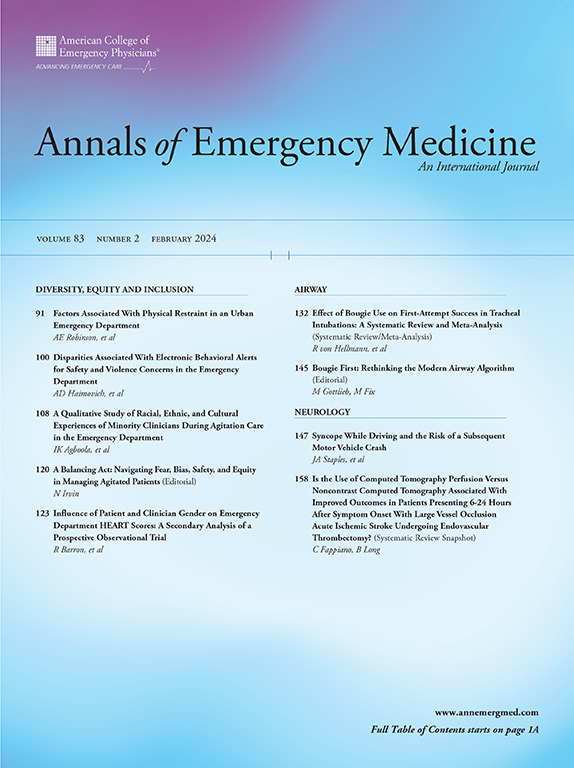Accuracy of Published Screening Tools for Large Vessel Occlusion in Patients With Suspected Acute Ischemic Stroke: A Prospective Cohort Study.
IF 5
1区 医学
Q1 EMERGENCY MEDICINE
引用次数: 0
Abstract
STUDY OBJECTIVE To identify the most accurate screening tool for predicting a large vessel occlusion in patients with a suspected acute ischemic stroke. METHODS Between January 2022 and April 2023, adult patients with a suspected acute ischemic stroke for whom an emergency physician activated the stroke code (indicating potential eligibility for thrombolysis and/or thrombectomy) at the emergency department (ED) of l'Hôpital de l'Enfant-Jésus-CHU de Québec, a tertiary care center for neurologic diseases, were prospectively included. Demographic data and variables included in 8 screening tools were collected by the emergency physician prior to the head computed tomography using a standardized data collection form. The performance of each tool to identify patients with a large vessel occlusion was assessed using the accuracy with 95% confidence intervals (CIs) and the McNemar test was used to compare the performance of the tools. RESULTS A total of 390 patients were included in the study (mean age: 72.3 years; men: 48.2%). Acute ischemic strokes was the final diagnosis in 259 patients (66.4%) of which 111 (28.5%) had a large vessel occlusion. The accuracy of Field Assessment Stroke Triage for Emergency Destination (FAST-ED) was 0.76 (95% CI 0.72 to 0.81), which was not significantly different from that of Rapid Arterial Occlusion Evaluation Scale (0.75, 95% CI 0.71 to 0.80), Los Angeles Motor Scale (0.75, 95% CI 0.71 to 0.79), or Large ARtery Intracranial Occlusion stroke scale (0.72, 95% CI 0.68 to 0.77). However, it was significantly higher than the accuracy of Conveniently-Grasped FAST, Ambulance Clinical Triage-FAST, Vision, Aphasia, Neglect assessment, and Face-Arm-Speech-Time plus severe arm or leg motor deficit. Cincinnati Prehospital Stroke Scale, when performed by either the emergency physicians or paramedics, demonstrated poor accuracy, with values of 0.34 (95% CI 0.29 to 0.39) and 0.37 (95% CI 0.32 to 0.34), respectively. CONCLUSION This study provides valuable insights into the accuracy of various large vessel occlusion screening tools for patients in our ED setting with FAST-ED, Rapid Arterial Occlusion Evaluation Scale, and Los Angeles Motor Scale showing the highest levels of accuracy. These findings will contribute to the development of evidence-based care pathways for improving stroke diagnosis and management.疑似急性缺血性脑卒中患者大血管闭塞筛查工具的准确性:一项前瞻性队列研究。
研究目的确定预测疑似急性缺血性脑卒中患者大血管闭塞的最准确筛查工具。方法:前瞻性纳入2022年1月至2023年4月期间,在神经系统疾病三级护理中心('Hôpital de l’enfantt - jsamus - chu de quacemobe)急诊科(ED)由急诊医生激活卒中代码(表明可能有资格进行溶栓和/或取栓)的疑似急性缺血性卒中成年患者。在头部计算机断层扫描之前,急诊医生使用标准化的数据收集表格收集了8种筛查工具中包含的人口统计数据和变量。使用95%置信区间(ci)的准确性评估每种工具识别大血管闭塞患者的性能,并使用McNemar检验来比较工具的性能。结果共纳入390例患者,平均年龄72.3岁,男性48.2%。259例(66.4%)患者最终诊断为急性缺血性中风,其中111例(28.5%)患者有大血管闭塞。急诊目的地现场评估卒中分诊(FAST-ED)的准确性为0.76 (95% CI 0.72 ~ 0.81),与快速动脉闭塞评估量表(0.75,95% CI 0.71 ~ 0.80)、洛杉矶运动量表(0.75,95% CI 0.71 ~ 0.79)或大动脉颅内闭塞卒中量表(0.72,95% CI 0.68 ~ 0.77)的准确性无显著差异。然而,它明显高于方便抓取快速、救护车临床分类快速、视力、失语、忽视评估和面部-手臂-言语时间加上严重的手臂或腿部运动缺陷的准确性。辛辛那提院前卒中量表,无论是由急诊医生还是护理人员执行,都显示出较差的准确性,分别为0.34 (95% CI 0.29至0.39)和0.37 (95% CI 0.32至0.34)。结论:本研究为我们急诊科患者的各种大血管闭塞筛查工具的准确性提供了有价值的见解,其中FAST-ED、快速动脉闭塞评估量表和洛杉矶运动量表显示出最高的准确性。这些发现将有助于循证护理途径的发展,以改善中风的诊断和管理。
本文章由计算机程序翻译,如有差异,请以英文原文为准。
求助全文
约1分钟内获得全文
求助全文
来源期刊

Annals of emergency medicine
医学-急救医学
CiteScore
8.30
自引率
4.80%
发文量
819
审稿时长
20 days
期刊介绍:
Annals of Emergency Medicine, the official journal of the American College of Emergency Physicians, is an international, peer-reviewed journal dedicated to improving the quality of care by publishing the highest quality science for emergency medicine and related medical specialties. Annals publishes original research, clinical reports, opinion, and educational information related to the practice, teaching, and research of emergency medicine. In addition to general emergency medicine topics, Annals regularly publishes articles on out-of-hospital emergency medical services, pediatric emergency medicine, injury and disease prevention, health policy and ethics, disaster management, toxicology, and related topics.
 求助内容:
求助内容: 应助结果提醒方式:
应助结果提醒方式:


